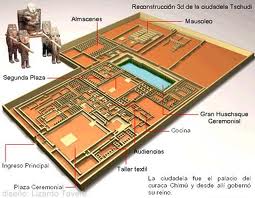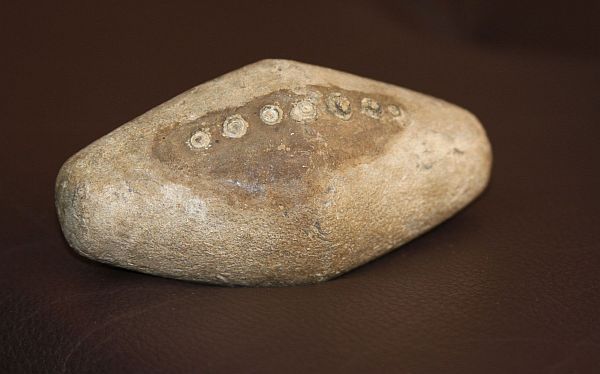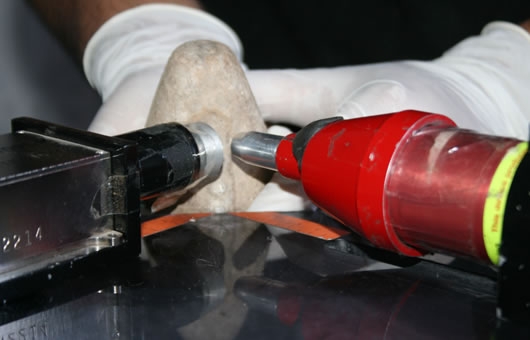It looks like you're using an Ad Blocker.
Please white-list or disable AboveTopSecret.com in your ad-blocking tool.
Thank you.
Some features of ATS will be disabled while you continue to use an ad-blocker.
10
share:
First I want to be sure everybody knows what is Chan Chan :

Now, regarding the object, it will change the whole game. Lead was supose to be unknown until the spaniard conquistadors came to America, as ammunition. The object has inlaid siver too.

It was discovered last August. Seems like scientists took their time to make it public, they thought it was made of iridium (from a meteorite), but just verified what was it really made of.

Now, this discovery will force us to rethink everythink about pre-columbian cultures. I just can't wait to read what you think about it my ATS friends.
elcomercio.pe...
en.wikipedia.org...
www.travel-amazing-southamerica.com...
laindustria.pe...
The largest Pre-Columbian city in South America, Chan Chan is an archaeological site located in the Peruvian region of La Libertad, five km west of Trujillo.[1] Chan Chan covers an area of approximately 20 km² and had a dense urban center of about 6 km².[2] Chan Chan was constructed by the Chimor (the kingdom of the Chimú), a late intermediate period civilization which grew out of the remnants of the Moche civilization. The vast adobe city of Chan Chan was built by the Chimu around AD 850 and lasted until its conquest by the Inca Empire in AD 1470. It was the imperial capital of the Chimor until it was conquered in the 15th century. It is estimated that around 30,000 people lived in the city of Chan Chan.

Now, regarding the object, it will change the whole game. Lead was supose to be unknown until the spaniard conquistadors came to America, as ammunition. The object has inlaid siver too.

It was discovered last August. Seems like scientists took their time to make it public, they thought it was made of iridium (from a meteorite), but just verified what was it really made of.

DETAILS
The object has the shape of a rhombus, sharpened at the ends and widened in the middle, with a height of 10.06 cm, a maximum diameter of 5.03 cm. and at least 2.04 cm. Weighs 1.550 kilos.
He was found by archaeologists in August Calipuy Liliana and Jose Armas during the work of conservation. Most archaeologists of Chan Chan and the specialist at the University of Yale, Colin Thomas, agree on the use ritual, magical and religious object.
Now, this discovery will force us to rethink everythink about pre-columbian cultures. I just can't wait to read what you think about it my ATS friends.
elcomercio.pe...
en.wikipedia.org...
www.travel-amazing-southamerica.com...
laindustria.pe...
edit on 18-1-2013 by Trueman because: (no
reason given)
I think that could be extremely important as a find and I'd say they ought to secure the site very carefully and move in with a whole lot more
professionals to start excavating as thoroughly but quickly as possible. Where there's one anomaly, I'll bet paychecks there are more ...and
probably more interesting as well as critical to understanding.
Just my thoughts...and I'm kinda keyed to looking for hints of tech levels which "shouldn't" be there. No X-files stuff, just a side belief that written history is as much s.w.a.g and assumption as anything factual ...and digging has literally only scratched the upper layers of the surface of what's to be found, IMO.
Finding this sure makes this an interesting site to pursue!
Just my thoughts...and I'm kinda keyed to looking for hints of tech levels which "shouldn't" be there. No X-files stuff, just a side belief that written history is as much s.w.a.g and assumption as anything factual ...and digging has literally only scratched the upper layers of the surface of what's to be found, IMO.
Finding this sure makes this an interesting site to pursue!
Thats where I lost that. Its the head to my lead frog I used as a good luck charm. The posts that held it to the body broke and the head separated.
You can see them clearly in the picture. I lost that last July while on vacation. How do I get a hold of them to get it back?
Seriously though that is a very interesting find. I am wondering if someone buried it during the time of lead but put it down far enough to throw off the dating?
Seriously though that is a very interesting find. I am wondering if someone buried it during the time of lead but put it down far enough to throw off the dating?
edit on 18-1-2013 by Agarta because: Spelling
reply to post by Trueman
If you turn it upright (like vertically), it looks like a figurine modeling the chakras.
If you turn it upright (like vertically), it looks like a figurine modeling the chakras.
reply to post by Wrabbit2000
And is important to keep in mind we are talking about one lead object in a city where 30,000 people lived. That object must have an special signification.
And is important to keep in mind we are talking about one lead object in a city where 30,000 people lived. That object must have an special signification.
Its a collector stone, collected all the left over radiation from the power devices in the city.
Originally posted by Newagekid2012
Its a collector stone, collected all the left over radiation from the power devices in the city.
It's not a stone.
I't sort of looks like a half-made ocarina.
Perhaps some type of healing device? Maybe a Pre-Columbian stress reliever.
Perhaps some type of healing device? Maybe a Pre-Columbian stress reliever.
A tiny coffin for the tiny aliens
Seriously though, thanks for the info. Always nice to see new discoveries that challenge the official history books. Been watching America Unearthed lately, really liking the investigation style they do on this show...only problem is, how do I know it isn't just being worked to fit in an agenda...Still intriguing...Thanks OP S & F.
Seriously though, thanks for the info. Always nice to see new discoveries that challenge the official history books. Been watching America Unearthed lately, really liking the investigation style they do on this show...only problem is, how do I know it isn't just being worked to fit in an agenda...Still intriguing...Thanks OP S & F.
Is it really that much of a 'game changer'? One of the archeologists who found it, Alfredo Narvaez, suggested it may have been made from Spanish
lead ammunition, mixed with Iron and other ores in use in the area. They've also suggested that Iron and lead weren't unknown to this region, just a
rarity. Peruvians have been recognized now as mining Iron for 2,000 years, long before the arrival of Europeans.
Ancient Iron Ore Mine Discovered in Peruvian Andes
Lead in Ancient Peru: the Curamba Smelter and Lead Sling Bullets
The object pictured in the OP would be described as "biconic", and not completely unknown - others have been found.
From "Mining and Metallurgy in Ancient Perú", By Georg Petersen G., writes:
So not really a game change. Ancient Peruvians knew about lead, before the arrival of Columbus or Spaniards.
Ancient Iron Ore Mine Discovered in Peruvian Andes
Lead in Ancient Peru: the Curamba Smelter and Lead Sling Bullets
Several precontact lead artifacts from ancient Peru have been described as bars (lingotes) or weights (pesos). However, alternatively, these artifacts might be more accurately described as: (a) biconic to ovoid (30 mm to 60 mm, 30 g to 40 g) or (b) spherical (35 mm, 80 g to 160 g)
The object pictured in the OP would be described as "biconic", and not completely unknown - others have been found.
From "Mining and Metallurgy in Ancient Perú", By Georg Petersen G., writes:
"lead is only rarely found as a native metal [...] native lead may be found in 1mm beads [...] In ancient times lead deposits were mined for their silver.
It is generally thought that ancient Peruvians did not specifically use or know about lead, however lead ores were certainly a part of silver production. Baessler (1906) suggests that lead ores were used only after the arrival of the Spaniards, however, there is sufficient archeological evidence to indicate that lead use is much older. In the Anthropology Museum (Berlin) are various lead objects (Schmidt, 1929)
So not really a game change. Ancient Peruvians knew about lead, before the arrival of Columbus or Spaniards.
Tie that to the end of a stick and you've got a pretty lethal weapon. That's my guess, a war hammer. Although I would have expected a grove in
the middle for easier attachment of the stick. But still, I wouldn't want to get hit in the head with it.
reply to post by Trueman
It has been known for some time that some Mesoamerican and South American cultures smelted lead. Lead was not considered to have arrived with the Spaniards: Link.
So, why did you say that?
The thing about your site is that it was only recently realized that the smelters there were for lead. They were previously thought to be for smelting silver.
Harte
It has been known for some time that some Mesoamerican and South American cultures smelted lead. Lead was not considered to have arrived with the Spaniards: Link.
So, why did you say that?
The thing about your site is that it was only recently realized that the smelters there were for lead. They were previously thought to be for smelting silver.
Harte
Originally posted by Harte
reply to post by Trueman
It has been known for some time that some Mesoamerican and South American cultures smelted lead. Lead was not considered to have arrived with the Spaniards: Link.
So, why did you say that?
The thing about your site is that it was only recently realized that the smelters there were for lead. They were previously thought to be for smelting silver.
Harte
Well, my initial post is based in the information found. I was counting with members like you, to help on a deeper investigation.Thanks
reply to post by Blackmarketeer
Amazing contribution to this thread, totally focused in the article, not killing the messenger. Thank you.
Amazing contribution to this thread, totally focused in the article, not killing the messenger. Thank you.
The poor scientist who deciphers the inlays will be shocked when he reads "danger radio active"
Being lead, theres no way to look inside by xrays, how about unltra sound or something?
Being lead, theres no way to look inside by xrays, how about unltra sound or something?
Originally posted by Trueman
Originally posted by Harte
reply to post by Trueman
It has been known for some time that some Mesoamerican and South American cultures smelted lead. Lead was not considered to have arrived with the Spaniards: Link.
So, why did you say that?
The thing about your site is that it was only recently realized that the smelters there were for lead. They were previously thought to be for smelting silver.
Harte
Well, my initial post is based in the information found. I was counting with members like you, to help on a deeper investigation.Thanks
I see.
Well, you're welcome.
It's what I do, you know.
Harte
maybe the circles used to have posts coming out, like nails kr something to attach it to its wooden or other type of handle. You can see the darkened
area around the circles where maybe there was once something there.
new topics
-
Let's talk planes.
General Chit Chat: 7 hours ago -
January 6th report shows disturbing trend (nobody is shocked)
US Political Madness: 9 hours ago -
Inexplicable military simulation - virtual reality showdown in the night..
The Gray Area: 9 hours ago -
The Truth about Migrant Crime in Britain.
Social Issues and Civil Unrest: 10 hours ago
top topics
-
Trudeau Resigns! Breaking
Mainstream News: 12 hours ago, 26 flags -
January 6th report shows disturbing trend (nobody is shocked)
US Political Madness: 9 hours ago, 20 flags -
Live updates: Congress meets to certify Trump's presidential election victory
US Political Madness: 13 hours ago, 12 flags -
The Truth about Migrant Crime in Britain.
Social Issues and Civil Unrest: 10 hours ago, 10 flags -
Gravitic Propulsion--What IF the US and China Really Have it?
General Conspiracies: 13 hours ago, 9 flags -
Let's talk planes.
General Chit Chat: 7 hours ago, 5 flags -
Greatest thing you ever got, or bought?
General Chit Chat: 14 hours ago, 4 flags -
Inexplicable military simulation - virtual reality showdown in the night..
The Gray Area: 9 hours ago, 2 flags
active topics
-
January 6th report shows disturbing trend (nobody is shocked)
US Political Madness • 50 • : RazorV66 -
Judge rules president-elect Donald Trump must be sentenced in 'hush money' trial
US Political Madness • 31 • : JadedGhost -
Gravitic Propulsion--What IF the US and China Really Have it?
General Conspiracies • 16 • : YouSir -
Trudeau Resigns! Breaking
Mainstream News • 65 • : firerescue -
Greatest thing you ever got, or bought?
General Chit Chat • 21 • : rickymouse -
Islam And A Book Of Lies
Religion, Faith, And Theology • 12 • : nugget1 -
Trump says ownership of Greenland 'is an absolute necessity'
Other Current Events • 65 • : BingoMcGoof -
Let's talk planes.
General Chit Chat • 7 • : rickymouse -
Democrats Introduce Bill That Will Take Away Donald Trumps Secret Service Protection
2024 Elections • 77 • : WeMustCare -
OK this is sad but very strange stuff
Paranormal Studies • 8 • : rickymouse
10
